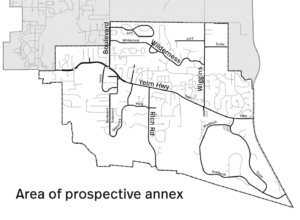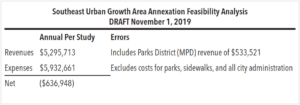Growth by annexation
Olympia officials are considering a major annexation of neighborhoods at the Southeast periphery of the city that would increase Olympia’s population by about 18%. If it moves ahead, the annexation will have a significant economic and political impact on the city of Olympia. All evidence to date shows an adverse effect: annexation would impose more expense on the city budget than the revenue produced by taxes from the area.
When the Growth Management Act went into effect in 1990, communities in Thurston County formed Urban Growth Areas (UGAs) where population growth was to be concentrated. Multiple purposes of the UGA included providing adequate land for future development; protecting rural agricultural land; and concentrating development to minimize the cost of providing for roads, schools and utilities.
The Olympia UGA includes areas along both sides of Yelm Highway, from Henderson Boulevard to the Chehalis-Western Trail (which forms the boundary between the Olympia and Lacey UGAs). The area is almost entirely residential, with small commercial businesses along Yelm Highway, a restaurant inside Indian Summer, and a golf course community at the SE edge of the potential annexation.
Some realities of municipal finance
Property taxes, sales tax and business taxes are the three pillars of municipal revenue. Areas that are primarily residential like that of the possible annexation produce primarily property tax, in contrast with areas with retail or office businesses that produce all three kinds of tax. When a city annexes an area, it’s responsible for providing services such as police, fire and parks. It also takes on the maintenance of roads. In general, residential annexations impose more expense than the revenue they bring in.
In the current Olympia budget period, property taxes contribute the smallest amount of the three taxes — projected to bring in $17 million. Business taxes provide $20 million, and sales tax $29 million. The annexation area would generate almost no additional business taxes. The only meaningful sales tax would be from mail-order purchases by residents in this area.
Economic impacts for the City of Olympia
The City has twice studied the potential impact of the annexation. City staff prepared a study in November, 2019, updated in May, 2020. The City also hired a consultant to examine the annexation, with a report in January, 2023. Both studies showed that the annexation would add more to city expenses than to revenues. That negative result would have been even worse had not both studies left out major costs and incorrectly added in revenues sources .
The 2019 study
The 2019 staff study looked at additional revenue from north and south annexation areas separately. Each was estimated to produce less new revenue than expense. The only categories of expense considered were these: fire, police, roads, stormwater, community development, and street lights. This study did not address additional expenses associated with sidewalks, bicycle lanes, parks, or city administration. Sidewalks alone, just for major roads and school walking routes, are at least a $5 million investment. And while additional labor expense for the Fire Department was considered, the estimated $10 -$20 million cost to build a fifth fire station to serve the area was omitted.
Overstated revenues and understated costs
The inclusion of Metropolitan Parks District (MPD) property tax as “revenue” is a significant error. Technically, the MPD is a separate government agency whose revenues can ONLY be used for parks and recreation purposes.
MPD revenue augments about $7 million/year in city funds appropriated for parks, plus about $2 million annually in a voted tax on electricity, natural gas, and telephone bills. However, the staff included zero additional amounts on the expense side for parks and recreation. MPD revenues cannot be used to pay for police, fire, roads, or other city expenses that were considered. When MPD revenue is properly excluded from the revenue calculation, the net annual loss to the city budget rises to over $1.1 million.
There will be expenses for physical parks as well as recreation programs if annexation were to occur. Olympia has a policy to provide neighborhood parks within a half-mile of all homes, which means one or two additional parks in addition to a Community Park planned on the south side of Yelm Highway.
These costs are missing from the analysis. This could add an additional $5 million in capital costs and $500,000 per year in operating costs not considered by the staff. In addition, under an agreement between the City of Olympia and MPD, 11% of all revenues from property tax, sales tax, business tax and utility tax is dedicated to parks purposes– yet these were not subtracted from the total when computing dollars available to meet other city expenses.
The staff study also fails to include general overhead expenses. These costs represent nearly 20% or about $30 million of the city’s total budget: city manager, city attorney, municipal court, city council, finance, human resources, and “strategic initiatives” (whatever the Council wants to do in a particular year).
Adding population adds to the budget. When Olympia’s population passed 50,000, the city added a second “assistant city manager.” The City Manager office has ten staff in the current budget, plus 7.5 in human resources, 22 in information services, 17 in finance and 5 in the City Attorney office.
Administrative staff generally grows in proportion to the budget. Tumwater, with half the population of Olympia, has significantly less than half of Olympia’s staffing. A 20% “overhead” allowance on top of the estimate of $5.9 million in direct expenses for the departments examined would add another $1.2 million to the net loss associated with this potential annexation.
Another potential expense not addressed in the staff study involves rural fire districts that would lose territory. When the City of Tumwater carried out a major annexation, it agreed to pay the losing fire districts three years’ worth of property tax to avoid litigation.
Bottom line. The 2019 study overstated revenues, understated costs, and still concluded that the annexation was a money loser for Olympia.
The 2023 ECONorthwest Study
City officials then decided to hire a consultant, ECONorthwest, to study the annexation from a more current perspective.
The ECONorthwest study looked at two scenarios: one that assumed formation of a Regional Fire Authority (RFA) and one that did not. This April, voters in Olympia and Tumwater rejected the proposal for an RFA, so at least for now, that scenario is not relevant.
The ECONorthwest scenario that assumed fire services remain within the city budget made many of the same errors as the 2019 staff study. It assumed zero increase in parks expense, zero increase in administrative expense, nothing for crosswalks, sidewalks, bike lanes, and other infrastructure capital and operating costs, and no dedication of 11% of general fund revenues for parks. Even with these errors and omissions, the ECONorthwest study showed a clear adverse impact on the City budget.
 For the scenario based on formation of an RFA, the EcoNorthwest study included a table showing a net positive impact on the City budget. (Taxpayers would still shoulder the costs, however, through charges imposed by the RFA.) However, this positive result was also based on the same errors and omissions as the staff study.
For the scenario based on formation of an RFA, the EcoNorthwest study included a table showing a net positive impact on the City budget. (Taxpayers would still shoulder the costs, however, through charges imposed by the RFA.) However, this positive result was also based on the same errors and omissions as the staff study.
Bottom line. The 2023 EcoNorthwest study overstated revenues, understated costs, and still concluded that the annexation was a money loser for Olympia.
Political consequences of annexation
The annexation precincts are almost entirely large-lot and newer single-family residences. There are some apartments in Wilderness and along Yelm Highway, and some townhouses in Indian Summer, but overall, these precincts contain voters more conservative than the average for Olympia.
In the 2020 Presidential campaign, for example, precincts that currently make up Olympia voted 78% for Joe Biden. The Biden vote in the annexation precincts ranged from 55% to 75%. This is not MAGA country, but based on vote data, every precinct in the annexation area is more conservative than the Olympia average.
Currently, the residents in the annexation area do not vote in city elections, but if annexed, they would. Adding 18% to the Olympia population in more conservative precincts could clearly change the outcome of elections.
For example, the most hotly contested election in 2021 was Spence Weigand, a fiscally conservative Democrat challenging Jim Cooper for City Council Position 7. Over $120,000 was spent by the three candidates in this race, with Cooper defeating Weigand in November by a margin of 54% to 45%. Weigand carried many of the perimeter precincts in Olympia, which are most similar to the annexation area. Adding thousands of more conservative voters could have changed the outcome of this race.
Winners and losers
Why are Olympia city officials considering this money-losing idea? There are several possible reasons. First, manifest destiny: the assumption that under the GMA, cities will eventually expand to the boundary. Second, Olympia is already providing water and sewer utility service, and our fire department regularly provides “mutual aid” to the two rural fire districts that now perform primary response. Bringing these customers into the City can seem logical. And third, City staff self-interest — managers and department directors of larger cities get paid more than those for smaller cities.
Is this a good idea for the people living in the annexation areas? They will pay significantly higher taxes: higher utility taxes and higher property taxes. These will add about $500—$1,000 per year per home, depending on value and utility consumption. On the other hand, residents will get city police and fire services, which are superior to the local fire districts and sheriff deputies now responding.
Do the residents have a choice?
Annexation requires a 60% vote of approval (based on value of holdings) from property owners in the annexation area. The City already has 60% “approval” in the form of “Waiver of Protest” agreements signed by developers as a condition of utility service. It’s unlikely that residents would have the opportunity to weigh in.
Where does it go from here?
The City Council Land Use and Environment Committee is scheduled to look at the annexation issue again, perhaps in June. They may set the proposal aside, or they may direct the Staff to initiate the annexation process. That process includes notification to property owners, a public hearing, a decision on a vote — all leading to a decision by the Olympia City Council. Analyses by both staff and consultants found that this annexation would impose substantial costs on Olympia and its current residents. Will the Council take those findings seriously?
Jim Lazar is an economist and former Thurston County Public Utility District Commissioner.
Be First to Comment